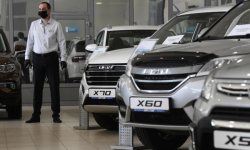The saturation of the Russian market with Chinese cars is at an unprecedented pace....

Ties with Asia helped Russia mitigate the effects of Western sanctions, writes Asia Times. Central Asian countries have become channels for parallel imports and transit trade. The "Central Asian effect" most affected the import of cars and goods of the chemical industry. But Chinese automakers have a special role in overcoming sanctions, according to a correspondent for The Moscow Post.
The blow of the Germans and the Japanese to the Russian car market was designed to cause dissatisfaction with the most active part of the Russian population, which managed to "get used" to the products of leading automakers. By the beginning of 2023, sales of new cars and light commercial vehicles fell by almost 60%, there was a shortage in the market, prices rose. The cost of original parts has grown by about 70-75% since the beginning of 2022.
After the imposition of sanctions, Lenta.ru reports, BMW, Renault, Hyundai, Toyota and Ford announced the closure of factories. Stopped supplying cars to the country Audi, Porsche, General Motors (Chevrolet and Cadillac), Jaguar Land Rover, Lexus, Volvo, Honda and other companies. With the outbreak of hostilities in Ukraine, most of the automakers, including Mercedes-Benz and Volkswagen, got rid of assets in Russia.
Budget AvtoVAZ also faced the need to bring to the market less dependent on imported components of the Lada Vesta and Niva models. There were problems in supply chains, especially chips. For a symbolic 1 euro, Japanese Nissan and Mazda parted with their assets, tire manufacturers Continental, Nokian Tyres and Michelin sold their factories.
The Chinese auto industry was at the center of these changes and, relying on Russian partners, in just a year managed to reconfigure the Russian passenger car market in its favor, to an upset of European and Japanese competitors. Sales of Chinese models have sharply gone to the top, joint assembly enterprises have appeared, negotiations are underway on new industries and those that may appear to replace existing ones, but stopped by former Western partners.
Almost like a "cheese experiment"
Asian economies have become not only alternative destinations for Russian exports, but also new sources of imports. Russian Foreign Ministry spokeswoman Maria Zakharova, speaking about the 11th package of EU sanctions, recalled that the EU has banned the supply of new and used cars to Russia with an engine capacity of more than 1.9 liters, as well as electric vehicles and hybrids.
This will lead to the growth of the Russian auto industry, including with the participation of China, "we liked the experiment with European cheeses," the diplomat joked about the restrictions. Someone added that China, with its annual volume of auto exports approaching 4 million cars, seemed to be waiting for these sanctions.
Russia in 2022-23 came out on top as the main foreign market of Chinese automakers. In the first half of 2020, the share of Chinese cars in the Russian market was 3%. According to the results of the third quarter of 2022, every fourth new car sold in the Russian Federation was Chinese, by November this share exceeded 30%, and this year it can grow to 40%. The representative of the Russian Automobile Federation believes that China's share in Russian sales of new cars may rise to 60%.
Bloomberg also noticed these shifts last week. In 2022 alone, China exported about 162 thousand cars to Russia, the agency writes. According to the Chinese Association of Automobile Manufacturers, in the first five months of this year, about 287 thousand finished cars were exported to Russia, almost twice as much as to Mexico, which ranks second as an importer of Chinese auto industry products.
Demand grows, dealers rebuild ties
The European Business Association is also monitoring the situation. Jealously, rivals such as Chery Automobile Co., Zhejiang Geely Holding Group Co. and Great Wall Motor Co. occupied about a third of the Russian new car market, supplying popular models such as Tiggo 7 Pro (Chery group), Coolray and Great Wall from the product line Haval (Geely Company)
By the beginning of July 2023, approximately 1.5 thousand Russian dealerships were selling Chinese cars. This amounted to about half of the number of points of sale and service of foreign cars in Russia.
In the study "Opening Auto" and "AutoBusinessRevue" there are data on brands: Jetour (74 dealerships), Kaiyi (65) and Livan (47), Changan and SWM (39 dealerships each), BAIC (36 dealerships), JAC (31), Tank (25), Chery (23), Geely (29). The most extensive network of dealerships in Russia at Chery (196 points), Geely (151 car dealerships) and Changan (127 dealerships).
The Russian government also allowed the import of cars from China without the consent of non-Chinese automakers - the so-called parallel imports. The import of cars with the receipt of the Certificate of Safety of the Vehicle Design (SBCTS) existed before, but with the closure of official channels, the volume of parallel imports increased
At the end of 2022, Meilin Auto was registered in Russia. This is a branch of one of the Chinese export companies, which previously did not work in Russia. Meilin CEO Chen Jiahao said that deliveries to Russia do not go directly, but through export companies to avoid risks. According to him, the sanctions do not interfere with supplies from the PRC, including Mercedes and Volkswagen.
Meilin intends to sell premium Chinese models in Russia, which are already exported to Europe and North America. According to representatives of the Avilon group, almost all foreign cars of the departed brands get from the PRC to the territory of the Russian Federation: Renault, Ford, Kia, Mazda, Hyundai, Opel, Peugeot and others.
Opportunity Time
According to the Governor of the Kaluga Region Vladislav Shapsh, 5.4 thousand employees of the automotive industry were "idle" in the conditions of sanctions. In the region, 18 automobile plants are to be restarted, which are partially or completely stopped, or are negotiating to resume production.
Last week, the Japanese company Isuzu announced the sale of a plant in Ulyanovsk. Three foreign automakers - Hyundai, Stellantis and Mitsubishi - have not yet announced their departure, although this step is expected in Moscow. The Hyundai conveyor in St. Petersburg was stopped in March last year. While Stellantis is silent (Peugeot, Opel and Citroen), owned by two-thirds of the PSMA Rus plant in Kaluga. The second owner of this car plant - the Japanese Mitsubishi (Outlander and Pajero Sport) also has a conveyor.
Some Western companies left Russia with an option to return, like Renault, which sold its stake in AvtoVAZ to FSUE NAMI, or Mercedes, which now belongs to the Avtodom dealer, as well as Nissan, which was first transferred to US, and then AvtoVAZ. The structure of the Avilon dealer was bought by Volkswagen in Kaluga.
Toyota decided to leave for good and the plant moved to Almaz-Antey, which will produce an E-Neva electric car and trucks. Truck manufacturers Scania and MAN transferred the assets of subsidiaries in St. Petersburg to local dealers. The joint venture between Kamaz and Daimler Kamaz Rus, which produced Mercedes trucks, came under the control of Kamaz. Mazda sold a share of the Vladivostok plant to its partner Sollers, which will produce pickups. Sollers also acquired the Isuzu truck factory in Ulyanovsk.
Russians do not walk
Contrary to expectations, the EU ban on the export of cars to Russia did not lead to "Russians starting to walk," Norwegian NRK reports. In the car dealership in Murmansk, the correspondent of this publication came across an SUV of the Exceed brand. Leather seats, modern electronics and all-wheel drive.
Alan Visser, who heads Geely-owned electric car company Lynk & Co, says Europeans are getting used to Chinese-made cars being of high quality. Once upon a time in the United States, they got used to the fact that Japanese cars turned out to be much more economical, more convenient and reliable than American ones, similar in those days to hippopotamuses.
Meanwhile, German publications such as Handelsblatt, Focus and Merkur write that the backbone automotive industry in Germany is in crisis, that car production has decreased by two million units per year, and it is generally unprofitable to produce electric vehicles. For comparison, BYD is the largest manufacturer of electric vehicles in China, produces batteries and microcircuits, intends to dominate the segment of budget electric vehicles.
Chinese car companies are said to be seeking to localize production. Zhou Liqun, chairman of the Union of Chinese Entrepreneurs in Russia, said in an interview with RIA Novosti that some companies are negotiating this. There are conditions for the development of production and localization. Local manufacturers will have to support high import duties on new and used cars, preferential car loans and leasing programs.
For example, Haval (a subsidiary of the Great Wall concern), having a plant in the Tula region, holds the third place in sales in the Russian Federation and will collect about 100 thousand cars this year models Haval Jolion, Haval F7, Haval F7x, Haval Dargo and Haval H9. The company plans to complete the engine plant near Tula.
By the end of 2023, the company intends to expand the range by eight more models, assemble pickups and achieve localization of production by more than 80%. It is possible that modifications for the Russian market of such cars as Chery Omoda, as well as new brands, including Chery Arizona sedans, Ora Lightning Cat, as well as Tank, will appear on the market.
AvtoVAZ at the facilities of the former Nissan concern plant in St. Petersburg began to assemble the city crossover Lada X-Cross 5. The new car is produced in conjunction with the Chinese company FAW, the new "Lada" is based on the FAW Bestune T77 model.
In December last year, the capital's Moskvich plant began assembling compact SUVs identical to the Chinese Jac JS4. This crossover competes with the Hyundai Creta. Jac cars are also sold in Norway. The then director of the plant, Dmitry Pronin, said that it was planned to sell 50,000 Muscovites this year, and every fifth would be electric.
Electric drives in Norway are especially appreciated and, perhaps, such "Muscovites" will appear in Oslo car dealerships. In this case, the circle will not just close, as in the "experiment" with European cheeses. Maybe in the future, electric vehicles of joint Russian-Chinese development will contribute to the "greening" of the northern European fleet?
Читать на "The Moscow Post"
